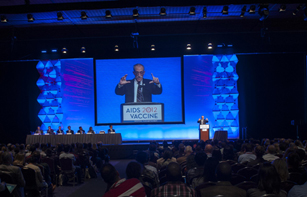
William Snow, Executive Director of the Global AIDS Vaccine Enterprise, organizer of the conference, speaking during the opening ceremony. Credit: Rick Friedman
From 9-12 September, more than a thousand HIV researchers and advocates, meeting in Boston for the AIDS Vaccine 2012 Conference, discussed the contribution of vaccine science to achieving the goal of zero new HIV infections in an increasingly complex HIV prevention landscape.
Several HIV prevention approaches such as male and female condom use, voluntary medical male circumcision, prevention of new HIV infections in children, post-exposure prophylaxis (PEP), pre-exposure prophylaxis (PrEP) and treatment as prevention, are now established tools to enable people to avoid exposure to HIV or to reduce their infectiousness. Modelling studies predict that by scaling up access to strategic combinations of these approaches that are adapted to local needs, national HIV programmes can significantly reduce the number of new HIV infections.
Do we need a vaccine?
Despite recent evidence that HIV treatment prevents onward transmission of HIV as well as the fact that vaccine discovery and development is costly in time and funding (US$845 million in 2011 alone), leaders from across the spectrum of HIV research attending the conference unanimously agreed on the need to continue the quest for an HIV vaccine.
Our knowledge is more sophisticated and moving much faster toward approaches and products that have a high likelihood of success in clinical trials
Professor Glenda Gray, Executive Director of the Perinatal HIV Research Unit, University of Witwatersrand and Director of the HIV Vaccine Trials Network Africa programmes
Professor Myron Cohen of the University of North Carolina at Chapel Hill, who led the multi-country study by the HIV Prevention Trials Network that proved the efficacy of AIDS treatment for prevention (the HPTN 052 study), said that scale-up of treatment is both a human rights imperative and an effective public health measure. At the same time, he threw his full weight behind the quest for a more effective HIV vaccine. “We recognize that suppressive treatment of HIV infection drastically reduces the probability of onward HIV transmission, which should eventually slow the spread of HIV. But the urgent and widespread treatment of HIV is not a substitute for a preventive vaccine. We need an HIV vaccine,” said Dr Cohen.
Vaccine trials
The RV144 vaccine trial in Thailand, which tested a combination of two vaccines, reported a modest 31% efficacy in 2009. However, it sparked a wide array of new questions about how and when the human immune system may respond to HIV. “Our knowledge is more sophisticated and moving much faster toward approaches and products that have a high likelihood of success in clinical trials,” said Professor Glenda Gray, Executive Director of the Perinatal HIV Research Unit, University of Witwatersrand and Director of the HIV Vaccine Trials Network Africa programmes. Currently there is only one HIV vaccine trial under way, which is testing a combination of experimental vaccines in men who have sex with men and transgender women in the United States (HVTN 505). Additional studies are planned, including three studies to pursue an improvement on the RV144 results in South Africa and Thailand, but these are not likely to begin before 2014.
Synergies between vaccine and non-vaccine prevention strategies
According to scientists at the conference, to evaluate any new technologies in human trials, the new product first must be proved safe, and then must be tested against the standard of care or prevention. They noted that, as the standard evolves to include new tools such as medical male circumcision, PrEP and early AIDS treatment, more complex trial designs are needed to evaluate the efficacy of the new technology, and larger sample sizes will be required.

L to r: Dr Dan Barouch, Professor of Medicine at Harvard Medical School, Chief of the Division of Vaccine Research at Beth Israel Deaconess Medical Center, and Co-Chair of the AIDS Vaccine 2012 conference and Dr Anthony Fauci, Director of the National Institute of Allergy and Infectious Diseases. Credit: Rick Friedman
Dr Anthony Fauci, Director of the National Institute of Allergy and Infectious Diseases pointed out that given the availability of other partially effective prevention strategies, the world may not need a vaccine that provides 95% protection. According to him, a vaccine that reduces risk in combination with other prevention strategies may be sufficient. Researchers at the conference said that there are also indications that antiretroviral-based prevention approaches could increase the vaccine effects or offer protection during the post-vaccination period when the immune system has to ramp up production of a protective antibody response.
Building knowledge one trial at a time
Participants agreed that large scale production of a prophylactic HIV vaccine is well over a decade away under the best of assumptions. Vaccine discovery, development, obtaining official license and scaling up production and delivery take many years and large investments. Mathew Rose, Policy Chair for the Young Black Gay Men’s Leadership Initiative, used a boxing metaphor to explain the challenge ahead. To sustain enthusiasm and commitment until a more effective AIDS vaccine is discovered, “we need to stop waiting for a single, knock-out punch, and instead, we must perfect the art of the jab,” said Mr Rose. “Each clinical trial may produce the final answer, or it may open up more key questions,” he added. According to Mr Rose, each new question will require a strategic study—a new “jab” that will build general knowledge about how the human body recognizes and fights infection, and will build the scientific capacity to finally outwit HIV.





